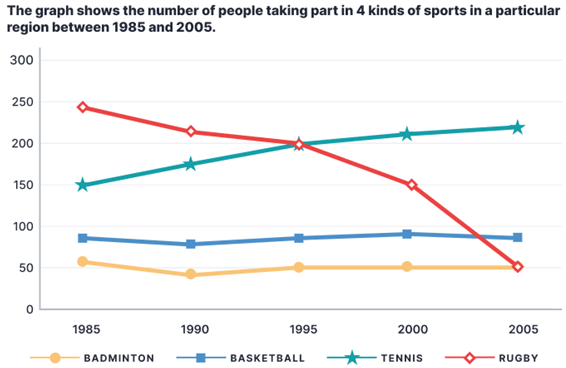5+ The graph shows the number of people taking part in 4 kinds of sports in a particular
The graph shows the number of people taking part in 4 kinds of sports in a particular region between 1985 and 2005. Summarise the information by selecting and reporting the main features, and make comparisons where relevant. Write at least 150 words hay nhất giúp bạn có thêm tài liệu tham khảo để viết bài luận bằng Tiếng Anh hay hơn.
- The graph shows the number of people taking part in 4 kinds of sports in a particular (mẫu 1)
- The graph shows the number of people taking part in 4 kinds of sports in a particular (mẫu 2)
- The graph shows the number of people taking part in 4 kinds of sports in a particular (mẫu 3)
- The graph shows the number of people taking part in 4 kinds of sports in a particular (mẫu 4)
- The graph shows the number of people taking part in 4 kinds of sports in a particular (mẫu 5)
- The graph shows the number of people taking part in 4 kinds of sports in a particular (mẫu 6)
5+ The graph shows the number of people taking part in 4 kinds of sports in a particular
Đề bài: The graph shows the number of people taking part in 4 kinds of sports in a particular region between 1985 and 2005. Summarise the information by selecting and reporting the main features, and make comparisons where relevant. Write at least 150 words
The graph shows the number of people taking part in 4 kinds of sports in a particular - mẫu 1
The line chart illustrates how many people participated in 4 distinct types of sports in a particular area from 1985 to 2005.
Overall, rugby was the most popular sport in the first half of the period while tennis took the lead in the second half. In addition, rugby saw a downward trend while tennis took the opposite direction; moreover, the trends for basketball and badminton were relatively stable.
In 1995, the number of people playing rugby stood at just under 250, surpassing the figure for tennis players by around 100. Basketball and badminton had comparatively lower participation rates, with around 80 and 50 participants in turn.
Afterwards, the number of people participating in rugby plunged, hitting a low of 50 in 2005, equal to the figure for badminton in the same year. In contrast, the trend for tennis was upward, with its participation rate increasing to roughly 220 people at the end of the period, establishing it as the leading sport. Finally, the figures for basketball and badminton underwent negligible changes, hovering around 80 and 50 participants respectively.
The graph shows the number of people taking part in 4 kinds of sports in a particular - mẫu 2
The line graph illustrates how many people participated in four types of sports in a specific area from 1985 to 2005. Overall, there was a significant decrease in the number of people playing rugby in this region, whereas tennis showed a gradual upward trend to become the most popular sport in the second half of the period. Additionally, throughout the period, the trends for basketball and badminton were relatively stable and comparable, with the latter sport remaining the least common.
In the first decade, rugby had the highest number of players, despite witnessing a steady fall from nearly 250 to exactly 200 participants. From 1995 onwards, this sport kept losing popularity as its figure plummeted, reaching parity with badminton (at 50 people) in the final year.
In contrast, tennis was gaining popularity and had become the dominant category by the end of the timeframe. Specifically, starting at the second highest (at 150), the number of people engaging in tennis rose continually, overtaking that of rugby in 1995 before ending at approximately 250 players.
Meanwhile, roughly 80 people played basketball initially, after which it stayed virtually unchanged until the end of the period. Badminton almost exactly mirrored this trend, albeit at a lower rate, consistently hovering around the 50 mark.
The graph shows the number of people taking part in 4 kinds of sports in a particular - mẫu 3
The line chart compares the number of participants in basketball, tennis, badminton and rugby over a 20-year period from 1985 in a specific area.
Overall, more people played tennis throughout the period, and it was the most common sport since 1995, while rugby's popularity declined. Notably, basketball and badminton mostly had stable numbers of players.
In terms of tennis and rugby, both sports indicated inverted trends. Although rugby started at the highest point with nearly 250 players, the figure declined continually to about 200 players in 1995, when this sport was no longer the most popular. Since then, the number of people playing rugby dropped more steeply, reaching 50 in 2005. In contrast, from 1985 onwards, the figure for tennis increased steadily from second place with 150 participants. By 2005, it had reached its highest point of roughly 220 players.
In comparison, there were far fewer people who took up basketball and badminton. However, these sports remained relatively stable, with basketball having about 70 participants every year, while badminton was always the least popular with approximately 50 players each year.
The graph shows the number of people taking part in 4 kinds of sports in a particular - mẫu 4
The line graph provides information about the number of individuals engaging in four types of sports in a specific area from 1985 to 2005.
Overall, while tennis underwent a surge in popularity, rugby experienced a decrease in participation within this region over time, with basketball and badminton remaining relatively stable. Moreover, the most drastic shift in popularity was witnessed in rugby.
At the start of the period, in 1985, rugby was the most played sport, with 240 individuals participating, and it significantly outnumbered the next sport, tennis, which had only 150 participants. Thereafter, the number of people playing rugby dropped to 200 in 1995, before plummeting to a 20-year low of 50 in the final year. This stood in stark contrast to the rise in the popularity of tennis, which saw a steady increase in participants to a peak of about 220 in 2005, making it by far the most played sport at the end of the period.
Turning to the remaining sports, in the first year, 80 individuals played basketball, almost 25 more than badminton. Over the following decade, the participant numbers for basketball rose to about 90, while those for badminton dropped to a low of 45 in 1995. In the remaining period, these two sports maintained their popularity, as the numbers participating stayed at roughly the same level until 2005.
The graph shows the number of people taking part in 4 kinds of sports in a particular - mẫu 5
The line chart delineates the participation levels in four distinct sports in a specific area from 1985 to 2005.
Primarily, rugby emerged as the most favored sport in the initial half of the period, while tennis took precedence in the latter half. Moreover, rugby exhibited a declining trend, whereas tennis experienced a converse trajectory. Meanwhile, the engagement rates for basketball and badminton remained relatively consistent.
In 1985, the number of rugby participants stood at just below 250, exceeding the tennis players by approximately 150 individuals. Simultaneously, basketball and badminton showcased lower participation rates, with around 80 and 50 individuals involved in each sport, respectively.
Subsequently, rugby participation plummeted significantly, reaching a nadir of 50 participants in 2005, akin to the number engaged in badminton during the same year. Conversely, tennis experienced an upward trend, escalating to nearly 220 individuals by the conclusion of the period, solidifying its status as the predominant sport. In contrast, the figures for basketball and badminton remained relatively stable, with approximately 80 and 50 participants, respectively, throughout the entire duration.
The graph shows the number of people taking part in 4 kinds of sports in a particular - mẫu 6
The given line graph delineates the participation levels in 4 different sports, namely basketball, tennis, badminton, and rugby within a specific region over a span of 20 years.
Overall, it is evident that the number of individuals participating in tennis witnessed a consistent and notable increase, contrasting sharply with the downward trend observed in rugby participation. Meanwhile, while basketball and badminton recorded lower participation rates compared to other sports, they remained relatively stable throughout the entire period.
Turning to the number of tennis players, the figures began at a relatively moderate level of 150 individuals in 1985. Subsequently, it experienced a gradual and consistent increase in participation, reaching a pinnacle of nearly 230 participants by 2005. In stark contrast, the trend of rugby involvement presented a distinctive pattern. Commencing at a relatively high level of almost 240 people, the numbers steadily declined over time and by the end of the 20-year period, rugby participants had dwindled to 50, matching the level of engagement observed in badminton. Interestingly, a point of convergence occurred in 1995, where both tennis and rugby shared a similar number of participants, with approximately 200 individuals engaging in each sport.
In regard to the remaining sports participants, the numbers for both badminton and basketball remained relatively stable over the given time frame. Beginning with approximately 50 individuals engaging in badminton and around 80 individuals involved in basketball in 1985, these figures persisted with little variation until 2005. Consequently, by the end of the period, both sports witnessed a culmination with nearly the same number of participants as they had at the beginning.
Xem thêm các bài luận Tiếng Anh hay khác:
Đã có app VietJack trên điện thoại, giải bài tập SGK, SBT Soạn văn, Văn mẫu, Thi online, Bài giảng....miễn phí. Tải ngay ứng dụng trên Android và iOS.
Theo dõi chúng tôi miễn phí trên mạng xã hội facebook và youtube:Nếu thấy hay, hãy động viên và chia sẻ nhé! Các bình luận không phù hợp với nội quy bình luận trang web sẽ bị cấm bình luận vĩnh viễn.
- Đề thi lớp 1 (các môn học)
- Đề thi lớp 2 (các môn học)
- Đề thi lớp 3 (các môn học)
- Đề thi lớp 4 (các môn học)
- Đề thi lớp 5 (các môn học)
- Đề thi lớp 6 (các môn học)
- Đề thi lớp 7 (các môn học)
- Đề thi lớp 8 (các môn học)
- Đề thi lớp 9 (các môn học)
- Đề thi lớp 10 (các môn học)
- Đề thi lớp 11 (các môn học)
- Đề thi lớp 12 (các môn học)
- Giáo án lớp 1 (các môn học)
- Giáo án lớp 2 (các môn học)
- Giáo án lớp 3 (các môn học)
- Giáo án lớp 4 (các môn học)
- Giáo án lớp 5 (các môn học)
- Giáo án lớp 6 (các môn học)
- Giáo án lớp 7 (các môn học)
- Giáo án lớp 8 (các môn học)
- Giáo án lớp 9 (các môn học)
- Giáo án lớp 10 (các môn học)
- Giáo án lớp 11 (các môn học)
- Giáo án lớp 12 (các môn học)






 Giải bài tập SGK & SBT
Giải bài tập SGK & SBT
 Tài liệu giáo viên
Tài liệu giáo viên
 Sách
Sách
 Khóa học
Khóa học
 Thi online
Thi online
 Hỏi đáp
Hỏi đáp

